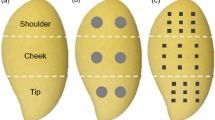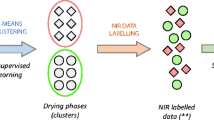Abstract
Habanero chillies (Capsicum chinense cv Habanero) are a popular species of hot chilli in Australia, with production steadily increasing. However, there is limited research on this crop due to its relatively low levels of production at present. Rapid methods of assessing fruit quality could be greatly beneficial both for quality assurance purposes and for use in breeding programs or experimental growing trials. This work investigated the potential of using infrared spectroscopy for the quality assessment of 20 Australian Habanero chilli samples, including the prediction of dry matter content, total phenolic content, ferric reducing antioxidant potential and capsaicin/dihydrocapsaicin content. Near-infrared spectra (908–1676 nm) taken from the fresh fruit showed strong potential for the estimation of dry matter content, with a root mean standard error of cross-validation (RMSECV) of 0.50% FW. A moving-window partial least squares regression model was applied to optimise the spectral window used for dry matter content prediction, with the best-performing window being between 1224 and 1422 nm. However, the near-infrared spectra of fresh fruit could not be used to estimate the total phenolic content or capsaicin/dihydrocapsaicin content of the samples. Mid-infrared spectra (4000 − 400 cm− 1) collected from the dried, powdered material showed slightly more promise for the prediction of total phenolics and the ratio of capsaicin:dihydrocapsaicin, with a R2cv of 0.45 and RMSECV of 0.32 for the latter parameter. Although further refinement is required, this method may be able to detect samples with high/low contents of total phenolics or for the estimation of the capsaicin:dihydrocapsaicin ratio.








Similar content being viewed by others
Data Availability
The datasets supporting the findings of this paper are available from the authors upon request.
References
N.T. Anderson, K.B. Walsh, P.P. Subedi, C.H. Hayes, Achieving robustness across season, location and cultivar for a NIRS model for intact mango fruit dry matter content. Postharvest Biol. Technol. 168, 111202 (2020). https://doi.org/10.1016/j.postharvbio.2020.111202
AustChilli (2019) 2019 Australian chilli trends. AustChilli. https://www.austchilli.com.au/blog/posts/2019/july/2019-australian-chilli-trends. Accessed 22 Jun 2021
AusVeg (2016) Veggie stats: chillies. Veggie Stats:19–21
C. Aza-González, H.G. Núñez-Palenius, N. Ochoa-Alejo, Molecular biology of capsaicinoid biosynthesis in chili pepper (Capsicum spp.). Plant Cell Rep. 30, 695–706 (2011). https://doi.org/10.1007/s00299-010-0968-8
M.-J. Bae, E.-S. Han, S.-H. Hong, Use of near Infrared Spectroscopy in Quality Control of Red Pepper Powder. J. Near Infrared Spectrosc. 6, A333–A335 (1998)
G. Bonifazi, R. Gasbarrone, S. Serranti Dried red chili peppers pungency assessment by visible and near infrared spectroscopy. In: SPIE Defense + Commercial Sensing, Baltimore, Maryland, 2019. Proceedings Volume 10986, Algorithms, Technologies, and Applications for Multispectral and Hyperspectral Imagery XXV. SPIE. https://doi.org/10.1117/12.2517069
A. Canto-Flick et al., Capsaicinoids Content in Habanero Pepper (Capsicum chinense Jacq. ): Hottest Known Cultivars. HortScience 43, 1344 (2008). https://doi.org/10.21273/hortsci.43.5.1344
A.M. Chapa-Oliver, L. Mejía-Teniente, Capsaicin: from plants to a Cancer-suppressing Agent. Molecules 21, 931 (2016). https://doi.org/10.3390/molecules21080931
H.W. Czarnik-Matusewicz, A. Korniewicz, Determination of Capsaicin in the Antirheumatical Plasters by near Infrared Reflectance Spectroscopy: a comparison of statistical methods. J. Near Infrared Spectrosc. 6, A181–A184 (1998). https://doi.org/10.1255/jnirs.191
C.B. Davis, C.E. Markey, M.A. Busch, K.W. Busch, Determination of Capsaicinoids in Habanero Peppers by Chemometric Analysis of UV Spectral Data. J. Agric. Food Chem. 55, 5925–5933 (2007). https://doi.org/10.1021/jf070413k
I. Domínguez-Martínez, O.G. Meza-Márquez, G. Osorio-Revilla, J. Proal-Nájera, T. Gallardo-Velázquez, Determination of capsaicin, ascorbic acid, total phenolic compounds and antioxidant activity of Capsicum annuum L. var. Serrano by mid infrared spectroscopy (Mid-FTIR) and chemometric analysis. J. Korean Soc. Appl. Biol. Chem. 57, 133–142 (2014)
B.H. Gangadhar, R.K. Mishra, G. Pandian, S.W. Park, Comparative study of Color, Pungency, and biochemical composition in Chili Pepper (Capsicum annuum) under different light-emitting diode treatments. HortScience 47, 1729 (2012). https://doi.org/10.21273/hortsci.47.12.1729
A. González-Zamora, E. Sierra-Campos, J.G. Luna-Ortega, R. Pérez-Morales, J.C.R. Ortiz, J.L. García-Hernández, Characterization of different Capsicum varieties by evaluation of their Capsaicinoids Content by High Performance Liquid Chromatography, determination of pungency and effect of high temperature. Molecules 18, 13471–13486 (2013). https://doi.org/10.3390/molecules181113471
I. Guzmán, P.W. Bosland, A matter of taste: Capsaicinoid Diversity in Chile Peppers and the importance to human food preference, in Capsaicin and its Human Therapeutic Development, ed. by G. Mozsik (IntechOpen, London, UK, 2018), https://doi.org/10.5772/intechopen.77317
M. Hamed, D. Kalita, M.E. Bartolo, S.S. Jayanty, Capsaicinoids, polyphenols and antioxidant activities of Capsicum annuum: comparative study of the Effect of Ripening Stage and Cooking Methods. Antioxidants 8, 364 (2019). https://doi.org/10.3390/antiox8090364
T. Ignat, V. Alchanatis, Z. Schmilovitch, Maturity prediction of intact bell peppers by sensor fusion. Comput. Electron. Agric. 104, 9–17 (2014). https://doi.org/10.1016/j.compag.2014.03.006
T. Ignat, Z. Schmilovitch, J. Fefoldi, B. Steiner, S. Alkalai-Tuvia, Non-destructive measurement of ascorbic acid content in bell peppers by VIS-NIR and SWIR spectrometry. Postharvest Biol. Technol. 74, 91–99 (2012). https://doi.org/10.1016/j.postharvbio.2012.06.010
M.A. Ilie et al., Capsaicin: physicochemical properties, cutaneous reactions and potential applications in painful and inflammatory conditions (review). Exp. Ther. Med. 18, 916–925 (2019). https://doi.org/10.3892/etm.2019.7513
J. Johnson, T. Collins, A. Power, S. Chandra, D. Portman, C. Blanchard, M. Naiker, Antioxidative properties and macrochemical composition of five commercial mungbean varieties in Australia. Legume Sci. 2, e27 (2020a). https://doi.org/10.1002/leg3.27
J. Johnson, T. Collins, D. Skylas, K. Quail, C. Blanchard, M. Naiker, Profiling the varietal antioxidative content and macrochemical composition in australian faba beans (Vicia faba L.). Legume Sci. 2, e28 (2020b). https://doi.org/10.1002/leg3.28
J.B. Johnson, J.S. Mani, M. Naiker, Gingerol, Shogaol and Paradol: The Chemistry of Pungent Ginger Constituents. In: Queensland Annual Chemistry Symposium, 2020c. pp 89–90
J.B. Johnson, J.S. Mani, D. Skylas, K.B. Walsh, S.P. Bhattarai, M. Naiker (2020d) Phenolic profiles and nutritional quality of four new mungbean lines grown in northern Australia. Legume Sci.:1. https://doi.org/10.1002/leg3.70
M. Kaiser, I. Higuera, F.M. Goycoolea, Capsaicinoids: occurrence, Chemistry, Biosynthesis, and Biological Effects, in Fruit and Vegetable Phytochemicals, 2nd edn., ed. by E.M. Yahia (Wiley, Hoboken, New Jersey, 2017), pp. 499–514, https://doi.org/10.1002/9781119158042.ch23
D.S. Kasampalis, P. Tsouvaltzis, K. Ntouros, A. Gertsis, I. Gitas, D. Moshou, A.S. Siomos, Nutritional composition changes in bell pepper as affected by the ripening stage of fruits at harvest or postharvest storage and assessed non-destructively. J. Sci. Food. Agric. (2021). https://doi.org/10.1002/jsfa.11375
T. Kopta, A. Sekara, R. Pokluda, V. Ferby, G. Caruso, Screening of Chilli Pepper genotypes as a source of Capsaicinoids and Antioxidants under Conditions of simulated Drought stress. Plants 9, 364 (2020). https://doi.org/10.3390/plants9030364
R. Lapcharoensuk, K. Danupattanin, C. Kanjanapornprapa, T. Inkawee, Combination of NIR spectroscopy and machine learning for monitoring chili sauce adulterated with ripened papaya. E3S Web Conf 187, 04001 (2020). https://doi.org/10.1051/e3sconf/202018704001
J. Lim, G. Kim, C. Mo, M.S. Kim, Design and fabrication of a real-time measurement system for the Capsaicinoid Content of Korean Red Pepper (Capsicum annuum L.) powder by visible and Near-Infrared Spectroscopy. Sensors 15, 27420–27435 (2015). https://doi.org/10.3390/s151127420
M. Mazourek, A. Pujar, Y. Borovsky, I. Paran, L. Mueller, M.M. Jahn, A dynamic interface for Capsaicinoid Systems. Biology Plant. Physiology 150, 1806–1821 (2009). https://doi.org/10.1104/pp.109.136549
F. Menichini et al., The influence of fruit ripening on the phytochemical content and biological activity of Capsicum chinense Jacq. cv Habanero. Food Chem. 114, 553–560 (2009). https://doi.org/10.1016/j.foodchem.2008.09.086
Z. Nagy, H. Daood, A. Nemenyi, Z. Ambrozy, Z. Pek, L. Helyes, Impact of shading net color on phytochemical contents in two chili pepper hybrids cultivated under greenhouse conditions. Hortic. Sci. Technol. 35, 418–430 (2017). https://doi.org/10.12972/kjhst.20170045
E.R. Naves, L. de Ávila Silva, R. Sulpice, W.L. Araújo, A. Nunes-Nesi, L.E.P. Peres, A. Zsögön, Capsaicinoids: pungency beyond Capsicum. Trends Plant Sci. 24, 109–120 (2019). https://doi.org/10.1016/j.tplants.2018.11.001
R. Ofori-Asenso, M.A. Mohsenpour, M. Nouri, S. Faghih, D. Liew, M. Mazidi (2021) Association of Spicy Chilli Food Consumption with Cardiovascular and all-cause mortality: a Meta-analysis of prospective cohort studies. Angiology:0003319721995666. https://doi.org/10.1177/0003319721995666
T.L. Olatunji, A.J. Afolayan, The suitability of chili pepper (Capsicum annuum L.) for alleviating human micronutrient dietary deficiencies: a review. Food Sci. Nutr. 6, 2239–2251 (2018). https://doi.org/10.1002/fsn3.790
Orchard Tech (2021) Chillies growth and production in Australia (2020). Orchard Tech. https://www.orchardtech.com.au/chillies-growth-and-production-in-australia-2020/. Accessed 22 Jun 2021
G. Palma-Orozco, C. Orozco-Álvarez, A.A. Chávez-Villeda, A. Mixtega-Martínez, R. Castro-Muñoz, Capsaicin content in red habanero chilli (Capsicum chinense Jacq.) And its preservation after drying process. Future Foods 4, 100070 (2021). https://doi.org/10.1016/j.fufo.2021.100070
P. Penchaiya, E. Bobelyn, B.E. Verlinden, B.M. Nicolaï, W. Saeys, Non-destructive measurement of firmness and soluble solids content in bell pepper using NIR spectroscopy. J. Food Eng. 94, 267–273 (2009). https://doi.org/10.1016/j.jfoodeng.2009.03.018
P. Phimchan, S. Techawongstien, S. Chanthai, P.W. Bosland, Impact of Drought stress on the Accumulation of Capsaicinoids in Capsicum Cultivars with different initial capsaicinoid levels. HortScience 47, 1204 (2012). https://doi.org/10.21273/hortsci.47.9.1204
R Core Team, R: A Language and Environment for Statistical Computing, Version 4.0.2 edn (R Foundation for Statistical Computing, Vienna, Austria, 2020)
T. San Park, Y. Min Bae, M. Jin Sim, D. Eun Kim, In Cho S (2008) Analysis of Capsaicinoids from Hot Red Pepper Powder by Near-Infrared Spectroscopy. Paper presented at the American Society of Agricultural and Biological Engineers Annual International Meeting 2008, Providence, Rhode Island, June 29 – July 2
M.-T. Sánchez, I. Torres, M.-J. de la Haba, A. Chamorro, A. Garrido-Varo, D. Pérez-Marín, Rapid, simultaneous, and in situ authentication and quality assessment of intact bell peppers using near-infrared spectroscopy technology. J. Sci. Food. Agric. 99, 1613–1622 (2019). https://doi.org/10.1002/jsfa.9342
F. Spiller et al., Anti-inflammatory effects of red pepper (Capsicum baccatum) on carrageenan- and antigen-induced inflammation. J. Pharm. Pharmacol. 60, 473–478 (2008). https://doi.org/10.1211/jpp.60.4.0010
E.M. Toledo-Martín, M.C. García-García, R. Font, J.M. Moreno-Rojas, P. Gómez, M. Salinas-Navarro, M. Del Río-Celestino, Application of visible/near-infrared reflectance spectroscopy for predicting internal and external quality in pepper. J. Sci. Food. Agric. 96, 3114–3125 (2016). https://doi.org/10.1002/jsfa.7488
M.S. Waite, A.J. Aubin, A Modular HPLC System for Routine Analysis of Capsaicin from hot Sauces (Waters Corporation, Milford, MA, US, 2008)
J. Workman, L. Weyer, Practical Guide to Interpretive near-infrared Spectroscopy (CRC press, Boca Raton, Florida, 2007)
Acknowledgements
The authors gratefully acknowledge the assistance of Phul Subedi in operating the MicroNIR instrument. We also thank Austchilli for supplying the chilli samples used in this study.
Funding
This work was supported in part by a New Staff Grant (RSH/5343) awarded by CQUniversity to one of the authors (MN). One of the authors (JJ) acknowledges support from the Australian Government in the form of a Research Training Program.
Author information
Authors and Affiliations
Corresponding author
Ethics declarations
Conflict of interest
The authors declare that no conflicts of interest exist.
Additional information
Publisher’s Note
Springer Nature remains neutral with regard to jurisdictional claims in published maps and institutional affiliations.
Rights and permissions
Springer Nature or its licensor (e.g. a society or other partner) holds exclusive rights to this article under a publishing agreement with the author(s) or other rightsholder(s); author self-archiving of the accepted manuscript version of this article is solely governed by the terms of such publishing agreement and applicable law.
About this article
Cite this article
Johnson, J.B., Mani, J.S., Walsh, K.B. et al. Infrared spectroscopy for the quality assessment of Habanero chilli: a proof-of-concept study. Food Measure 17, 1764–1774 (2023). https://doi.org/10.1007/s11694-022-01743-1
Received:
Accepted:
Published:
Issue Date:
DOI: https://doi.org/10.1007/s11694-022-01743-1




